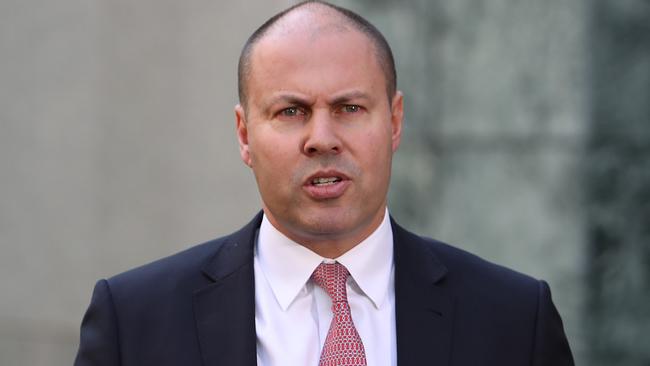Federal election court challenge: judge asks how Frydenberg win could be overturned
A judge hearing a challenge to the Treasurer’s election win points out an obvious flaw in the case.

One of three Federal Court judges hearing failed candidate Oliver Yates’s case against Josh Frydenberg has questioned how the court could possibly declare the Treasurer unelected, given the margin by which he won his seat in May.
Mr Yates is challenging Mr Frydenberg’s election in the Court of Disputed Returns, arguing voters were misled by Chinese corflutes which featured the colour scheme traditionally used by the Australian Electoral Commission and instructed them that the “correct” voting method was to put a “1” next to the Liberal candidate.
Unionist and environmental campaigner Vanessa Garbett is pursuing a concurrent challenge against Liberal MP Gladys Liu — who won the seat of Chisholm by 1090 votes — on the same grounds.
Questioning Mr Yates’s barrister Lisa De Ferrari SC as she summed up her case on Friday, Justice Andrew Greenwood said that even if every Chinese speaking voter, following Ms De Ferrari’s calculations, saw the corflute and voted for Mr Frydenberg, the Treasurer would still have won his seat by 4329 votes.
“What you want us to do is say ... we should declare Mr Frydenberg not elected. How can we possibly do that?” Justice Greenwood asked Ms De Ferrari.

Mr Frydenberg received 49.41 per cent of the primary vote in May compared with Mr Yates’s 8.98 per cent, and secured a two-party-preferred margin against Greens candidate Julian Burnside of 11,289 votes.
Mr Frydenberg’s barrister Philip Solomon QC earlier argued that voters would not only need to be Chinese speakers, but would also need to be non English speakers, in order to be persuaded by the corflutes.
“(It) can’t sensibly be countenanced that someone who reads English could see this corflute, in the context of the 30 or 50 other corflutes, and conclude that it comprises a mandatory demand from a statutory body not otherwise permitting choice,” Mr Solomon said.
He said Mr Yates’s lawyers had failed to produce evidence, even on a hearsay basis, that a single Chinese-speaking voter had been misled by the corflutes.
“It’s a very stark feature of the case that it’s not part of the petitioner’s proof to establish that even one Chinese reader attended at a polling place, read the corflute, voted Liberal and afterwards came to understand that it wasn’t a command and that their vote had been impinged or impaired accordingly. Not one.” Mr Solomon said.
The barrister argued acting Victorian Liberal Party director Simon Frost’s idea for the signs had come from similar Mandarin signs in the same colour scheme which were used by Labor during the Bennelong by-election in Sydney in 2017.
Mr Solomon conceded Mr Frost had made a “dramatic admission” on Wednesday that the corflutes were “intended to convey the impression” that they were produced by the Australian Electoral Commission during cross-examination by Ms De Ferrari.
However, Mr Solomon argued the admission was irrelevant, because the case relates to “misleading conduct in relation to the casting of a vote”.
“It certainly wasn’t suggested to Mr Frost that it was likely to affect the casting of a vote,” Mr Solomon said.
“Nor was it suggested to Mr Frost that it was likely to cause an elector to vote Liberal having attended with a different objective.”
Ms De Ferrari argued Mr Frydenberg’s lawyers had relied upon outdated 2016 census data, which did not take in details of Chinese speakers who were not from mainland China in their calculations of the proportion of Chinese speaking voters in Kooyong and Chisholm.
“The evidence that we rely upon establishes that the percentage of Chinese speaking constituents in Kooyong is increasing,” Ms De Ferrari told the court.
“Any mathematical approach of multiplying voters by 2016 census numbers is mistaken.”
Ms De Ferrari also argued the group of voters who may have been persuaded by the corflutes extended beyond Chinese speakers, to include other voters who may have been told about corflute message or assisted to vote by Chinese speakers.
The corflutes were distributed in seven eastern Melbourne electorates with significant Chinese populations, including Chisholm and Kooyong.
There is no legislative guarantee in Australia of truth in political advertising.
The AEC dismissed complaints about the signs on election day, saying the signs were authorised by the Liberal Party and there were no rules about colour schemes.
On Thursday AEC barrister James Renwick SC argued that it was “inherently implausible” that voters were sufficiently “gullible and naive” as to have been persuaded by the signs.
Chief Justice James Allsop and Justices Andrew Greenwood and Anthony Besanko reserved their decision on Friday to a date to be fixed.




To join the conversation, please log in. Don't have an account? Register
Join the conversation, you are commenting as Logout